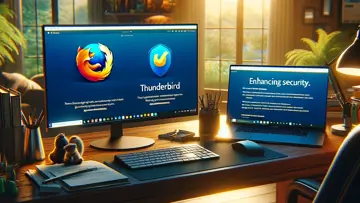Reviving the Past: Virtual AGC Brings Apollo Guidance Computer to Life
Virtual AGC offers an immersive experience for enthusiasts and historians, allowing users to explore the workings of the legendary Apollo Guidance Computer with remarkable authenticity.
Overview of Virtual AGC
Virtual AGC (Apollo Guidance Computer) is a meticulous simulation tool developed by the Virtual AGC Project aimed at faithfully recreating the early Apollo spacecraft's guidance and control systems used during lunar missions. This software stands as a tribute to NASA's monumental efforts in space exploration during the 1960s and 1970s, offering users an extensive and immersive experience that emphasizes fidelity to historical accuracy.
Key Features
- Authentic Software Recreation: Virtual AGC meticulously reproduces the original software coded for the Apollo Guidance Computer, allowing users to understand and interact with the software as it was used during pivotal moments of space travel.
- Comprehensive User Manual: Alongside the software, a rich array of documentation is available. This includes operational guides, technical references, and explanations of complex functions, essential for both enthusiasts and researchers.
- Support for Multiple Platforms: Virtual AGC is designed to run on various operating systems, ensuring accessibility for a wide range of users including enthusiasts, developers, and educators.
- Extensive Add-Ons: The platform allows for additional modules and enhancements created by the community, contributing to a continuously evolving ecosystem that enriches users' experiences.
- Open-Source Collaboration: As an open-source project, Virtual AGC invites collaboration from developers worldwide encouraging contributions that enhance its functionalities, quality, and user experience.
Utility in Education and Research
The functionality of Virtual AGC extends beyond mere simulation; it serves as a powerful educational tool. Institutions can leverage this software in subjects ranging from aerospace engineering to computer science. Its capabilities facilitate a deeper understanding of programming languages and system design principles from an era marked by innovation and complexity.
User Experience
The user interface of Virtual AGC is designed to replicate the look and feel of the original guidance computers used during the Apollo missions. While its retro aesthetic might appear stark compared to modern applications, it is intentionally reflective of historical designs. This immersive experience allows users to engage more deeply with the intricacies of Apollo's navigation systems.
Community Engagement
A robust community surrounds Virtual AGC, fostering discussions among amateur aerospace enthusiasts, historians, educators, and software developers. The project encourages active participation through forums, GitHub repositories, and public events. This vibrant exchange benefits users by providing peer support and fostering collaborative learning.
Technical Specifications
- Programming Language: The core software is written in assembly language for optimal performance on the original hardware architecture.
- Compatibility: It operates effectively across various platforms including Windows, Linux, and macOS.
- System Requirements: A compatible operating system with sufficient computational resources to simulate real-time operations of the guidance computer.
- Documentation Format: Available in multiple formats including PDF for ease of access across devices.
Installation Process
- Download the latest version of Virtual AGC from the official project website or GitHub repository.
- Unzip the downloaded files into your desired installation directory.
- Follow installation instructions outlined in the included README file to configure your environment appropriately.
- If necessary, modify any relevant system paths or dependencies as per your OS requirements.
- Your set-up should now be complete; launch Virtual AGC to begin exploring its functionalities.
Troubleshooting Common Issues
User feedback has led to documentation addressing common pitfalls in using Virtual AGC. Frequent concerns include:
- Compatibility Errors: Ensure your system meets the specified requirements and that all necessary libraries are installed.
- User Access Rights: For some operating systems, running as an administrator may be required to ensure proper functionality.
- Lack of Documentation: Users are encouraged to refer to both online communities and project-driven documentation for support throughout their experience.
The Future of Virtual AGC
The ongoing development of Virtual AGC signals its commitment to preserving aerospace history while making it accessible to contemporary audiences. Future updates are expected to enhance user interface features further along with more interactive elements that parallel current software trends while maintaining historical relevance. With community engagement aiding its evolution, Virtual AGC will likely continue serving educational purposes for years to come.
This application stands out as a vital resource for anyone interested in space exploration history or programming principles rooted in earlier technological paradigms. By merging historical fidelity with modern educational tools, Virtual AGC creates a unique learning platform that ensures continued engagement with the legendary Apollo missions.
Overview
Virtual AGC is a Commercial software in the category Development developed by Virtual AGC Project.
The latest version of Virtual AGC is currently unknown. It was initially added to our database on 07/26/2009.
Virtual AGC runs on the following operating systems: Windows.
Virtual AGC has not been rated by our users yet.
Pros
- Open-source software allowing for modifications and improvements by the community.
- Accurately simulates the Apollo Guidance Computer (AGC) used in NASA's Apollo missions, offering an authentic experience for users.
- Provides a great educational tool for those interested in aerospace engineering and computer science.
- Supports multiple platforms including Windows, macOS, and Linux.
- Has a comprehensive set of documentation and resources available to help users understand its functionalities.
Cons
- Requires a decent level of technical knowledge to set up and use effectively, which may alienate casual users.
- User interface may feel outdated compared to modern software applications.
- Limited community support due to a niche user base, making it harder to find solutions to specific problems.
- Performance can be influenced heavily by the hardware specifications of the user's machine.
- Not as user-friendly as more modern simulation software, which may deter some users.
FAQ
What is Virtual AGC?
Virtual AGC is a simulation of the Apollo Guidance Computer (AGC) that was used in the Apollo missions to the Moon.
How does Virtual AGC work?
Virtual AGC recreates the behavior of the original AGC by running the same software code and emulating its hardware components.
Is Virtual AGC accurate?
Yes, Virtual AGC aims to be a faithful representation of the original AGC, providing an accurate simulation of its operations.
Can I use Virtual AGC to run Apollo programs?
Yes, Virtual AGC allows users to run and interact with original Apollo software programs.
What platforms is Virtual AGC available for?
Virtual AGC is available for Windows, macOS, and Linux operating systems.
Is Virtual AGC open source?
Yes, Virtual AGC is an open-source project, allowing users to access and modify the codebase.
Are there tutorials available for Virtual AGC?
Yes, Virtual AGC Project provides documentation and tutorials to help users understand and use the software.
Can Virtual AGC be used for educational purposes?
Yes, Virtual AGC is a valuable educational tool for learning about the Apollo missions and computer systems.
Is there a community around Virtual AGC?
Yes, there is an active community of users and developers who contribute to the Virtual AGC Project.
Is Virtual AGC free to use?
Yes, Virtual AGC is free and open-source software, available for use by anyone interested in exploring its capabilities.

Peter Salakani
I'm Peter, a software reviews author at UpdateStar and content specialist with a keen focus on usability and performance. With a background in both software development and content creation, I bring a unique perspective to evaluating and discussing general software topics. When I'm not reviewing software, I enjoy staying updated on the latest tech trends, experimenting with new applications, and finding innovative solutions to everyday tech challenges.
Latest Reviews by Peter Salakani
Latest Reviews
|
|
Art
Unlock Your Creativity with Art by Fogware Publishing |
|
|
8-Bit Armies
Nostalgic Strategy Reimagined in 8-Bit Armies |
|
|
boxes
Innovative Design Tool for Efficient Organization |
|
|
eduVPN Client
Secure and Easy Access to Educational Networks with eduVPN Client |
|
|
o2 Cloud
Seamless Cloud Solutions with o2 Cloud by O2-De |
|
Gorn
Brutal Gladiatorial Combat in VR Delivers an Unforgettable Experience |
|
|
UpdateStar Premium Edition
Keeping Your Software Updated Has Never Been Easier with UpdateStar Premium Edition! |
|
|
Microsoft Edge
A New Standard in Web Browsing |
|
|
Google Chrome
Fast and Versatile Web Browser |
|
|
Microsoft Visual C++ 2015 Redistributable Package
Boost your system performance with Microsoft Visual C++ 2015 Redistributable Package! |
|
|
Microsoft Visual C++ 2010 Redistributable
Essential Component for Running Visual C++ Applications |
|
|
Microsoft OneDrive
Streamline Your File Management with Microsoft OneDrive |





